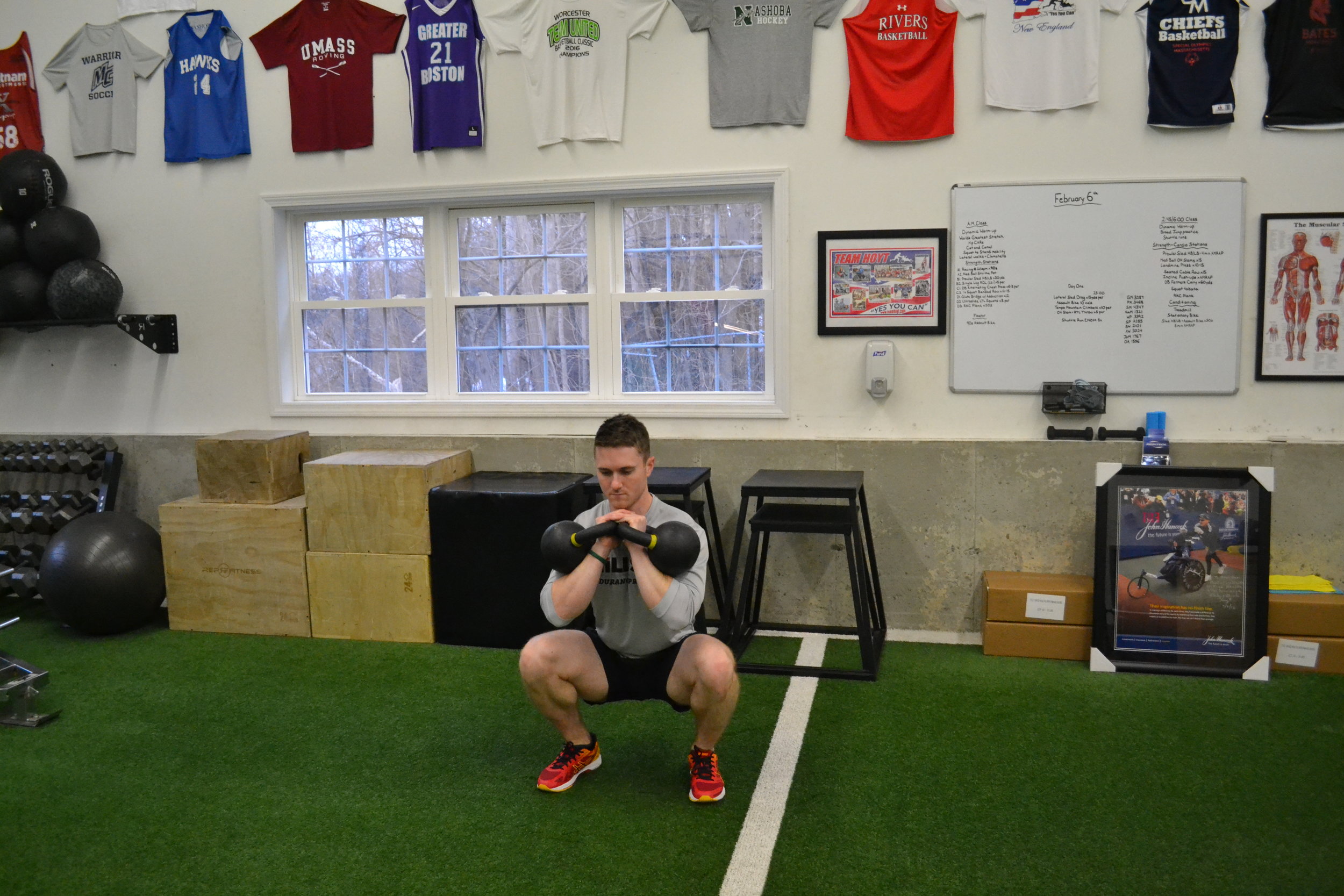Five Steps to a Stronger Boston Marathon
The Boston Marathon is a race like no other. Besides the unpredictability of the weather and the quantity of spectators it attracts, the elevation map is unique and should dictate the structure of your training. Whether you run 3 or 5 times a week, 6, 40 miles or 100 miles, below are five quick tips that you can implement, increasing the likelihood of you crossing that finish line with a performance that you’re proud of.
1.) Build your Brakes
Last year I watched the marathon from Mile 9. As I watched, constantly checking my phone to track my runners, a woman pulled off to the side next to me and expressed how much her hips and knee were hurting. While the undulations in Newton culminating with a climb of Heartbreak Hill garner a lot of attention, and rightfully so, if you look at the elevation map of the course, the first nine miles are largely downhill. A study by Gottschall and Kram in the Journal of Biomechanics showed that “at −9°, the normal impact force peaks increased by 54%, and the parallel braking force peaks increased by 73%”. With the quadriceps playing a primary role in force absorption; weakness in this muscle group will place more of the deceleration and absorption burden on the knee and hip joints.
Incorporate downhill running into your routine while complementing your mileage with strength training that builds eccentric strength in the quadriceps and posterior tibialis.
2.) Run Hills
Once you’ve built up strength in the supporting structures to handle the rigors of the first half of the race, the infamous hills await you. To neglect hill repeats and sprints would leave you relatively unprepared for miles 16-21. Ascending hills is demanding on hamstrings and calves. While they can be strengthened in the gym, incorporating routes with significant climbs as well as specific hill repeat workouts will produce a better result.
Hill repeats, especially when you push to maintain race pace, have a physiological demand similar to strength training. Therefore, in a training plan, adequate recovery must be scheduled between the two. For example, if you strength train on Tuesdays and Thursdays, maybe every other Thursday you shorten your strength training routine and finish up with hill repeats. There is an infinite number of ways to incorporate hill training and the frequency and intensity of these workouts is largely dependent on where you are in your training cycle.
3,) A Need for Speed
Heading to the track and running the hardest 400m interval you can without a specified rest period, and then attempting to repeat this pace with diminishing results is not characteristic of purposeful speed work. Depending on your experience level as well as how many weeks you have to prepare for the race will dictate how much time you can spend working on speed. If your goal is to run a 3:30 marathon (~ 8:00/miles) and the fastest mile you can run in isolation is 6:00 then you are operating at 75% intensity. However, if you can improve your mile time trial to 5:30, then that intensity dips below 70%. Being able to sustain a 68% effort will be easier than maintaining 75%. While race performance isn’t this mathematical and linear, you can’t run a faster marathon without getting faster.
Our favorite marathon speed workouts are:
Fartleks – Easy or tempo runs with brief bursts throughout; either planned or variable
Track Repeats - These can be structured in an unlimited number of ways. If you were to strictly run 400m or 800m repeats with a prescribed rest period in between, eventually you have to progress this workout so it contributes to you being able to maintain a given pace for longer. You can do so by running a longer interval or reducing the amount of rest you have between repeats. To make these speed workouts more applicable to the demands of a marathon, make the pace of your repeats slightly slower, and instead of complete rest, start by filling this time in with easy running. Progress to the point where you’re “recovering” between hard repeats with a race pace interval. This simulates a race scenario where you have to exert yourself harder on a given stretch (hill, etc) and then settle back into race pace.
Pace Extension – You can’t expect to extrapolate a pace over the course of 26.2 miles if you don’t spend time building up your tolerance to sustain this pace for longer periods of time. How do you know what pace to choose for this? Double your best half marathon performance (ideally one not too far in the distant past) and add 10-12 minutes. This can be your goal marathon pace. With an effective plan, or if you’re a new runner, this can improve over the course of the training cycle.
4.) Strength Train for Power
Many runners may not be comfortable lifting heavy weights or don’t believe that time spent learning the techniques of complex movements is worthwhile. However, strength training’s return on investment will exceed that of the time you spend on junk miles and machine-based training if structured and programmed properly.
A marathon strength training routine shouldn’t attempt to replicate the perceived effort or energy systems of running. By doing so, you are only interfering with the body’s competition for resources to recover from similar demands, and completely omitting qualities of fitness that can improve endurance performance; qualities that can only be developed in the gym and not out on the road.
Early in a training cycle, strength training can revolve around movement proficiency and muscle development. However, as your mileage ramps up and you incorporate more speed and tempo work it may be most effective to shift to lower volume strength and power work.
Prioritize the compound movement patterns (squat, deadlift, press, pull), perform them at a variety of intensities, speeds, and with sufficient rest so that the same degree of effort can be repeated. Since power is the product of how much force you can put into the ground, and how quickly you can recruit the musculature necessary to do so, developing sufficient strength and size prior to targeting the power side of the equation will prepare you for better results. While runners may worry about “unnecessary” muscle mass slowing them down, the concern should be more focused on how to structure training so that the athlete can optimize qualities of strength and endurance simultaneously. To address the intricacies of this topic would require diving into a lot more detail than this blog is aiming to address. The goal of this post is to offer a few tips that can be easily implemented into your training, not to overwhelm you with the science of concurrent training (developing strength and endurance qualities simultaneously).
The main takeaway is that you should not be hesitant to incorporate strength training. Train safely but heavy and explosively. If you are unsure how to safely and most efficiently do so, we would be happy to guide you in the right direction.
5.) Prioritizing Recovery is an Everyday Task
Throughout a marathon training cycle the physical stress placed on the musculoskeletal system is high and often unrelenting. If you want to remain consistent with training and progress speed and mileage accordingly, you must prioritize recovery. Sufficient sleep, adequate hydration, and proper nutrition compose the core of this recovery effort. However, often overlooked is how soft tissue work can help you stay injury free and performing well.
Focus on your feet, calves, and quads. Use different tools: foam rollers, stick rollers, lacrosse balls, etc. Get barefoot and move your joints through their full range of motion as often as possible. Your workouts are only as effective as the stimulus you can recover from.
Every workout during a marathon training cycle is an opportunity to improve one of the many physical qualities that go into a successful marathon. Make sure you understand the purpose of each workout and execute accordingly. Not sure how all of these variables tie together? Don’t hesitate to email us at unifiedhp@gmail.com. Follow us on Instagram [@unified.hp] and Facebook [Unified Health and Performance] to connect with us and stay up to date with our posts.
Running the marathon this year? We'd love to help out with our at-home strength routine and 20 week training plan. Email unifiedhp@gmail,com with the subject line: Boston Marathon Training if interested.





